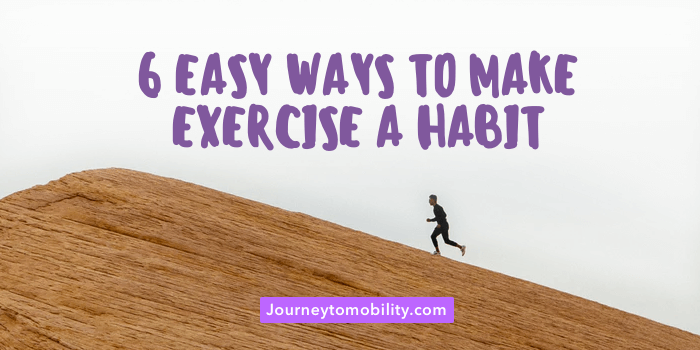A lot of people find it difficult to form an exercise habit and stick to it. Thankfully, there are strategies that make it easier to turn exercise into a habit that you can stick to.
I’ve worked out six to seven times a week consistently for over 6 years. When I get asked how I do it – my response is… that I can tell you how often I’ve worked out last week, two weeks ago, a few months ago and which workouts I did each of those days. If I asked you – would you have an answer?
Building an Exercise Habit
Fitness is a personal journey – it takes weeks, months and years of work but it all starts off with what you’re doing each day. The 5 workouts you did today add up to the 2 you do tomorrow. Every little step you make adds up. You need to be patient because good things can’t always be seen.
Working out needs to become part of your daily routine rather than something you feel like you need to make time for. When exercising becomes a habit, it’s easy because you no longer need to decide whether or not you’re going that day, you’ll just go. By then, daily exercise would be part of your schedule rather than something you need to schedule in.
Overview
- Have a workout plan
- Fill-in an empty workout calendar
- Take progress pictures
- Celebrate small wins
- Call out your excuses
- Don’t work towards an end result
6 Easy Ways to Make Exercise a Habit
Before exercising becomes a habit, you can keep yourself accountable by keeping track of the workouts you’ve done. The 6 tips below have helped me stay consistent with my personal fitness routine.
1) Have a Workout Plan
Don’t just go to the gym and “do whatever” (I’m super guilty of this!). To make progress, you need to know what you are working on right now, what workouts you’ve done and what your next workouts are. If you are taking fitness classes – which classes are you taking and how often will you go? Wherever you choose to workout, have a plan.

2) Fill-in an Empty Workout Calendar
If you’re reading this and today isn’t the first day of the month then it’s okay- simply draw out the remaining weeks. There really shouldn’t be anything stopping you from starting right now.
Next, fill in the workouts you complete each day. If it’s a workout video, put down how long the workout was and the title of the video (ex. “6 minute Booty Lifting Workout”). If it was a gym day, write down how much time you were there for and what you trained (ex. “1 hour Loaded Mobility Training for Front Splits”). Your calendar should start off empty and fill up as the days go by. That way it’s transparent and you know exactly how much work you’ve put in.

3) Take Progress Pictures Often
Progress pictures help you see the changes that you don’t always notice on yourself. If you’re training for flexibility, I recommend getting into the habit of taking a picture or video at the end of each training session. Progress for flexibility tends to come quite slowly at first as you learn how your body works and what feels right.
For weight lifting, take pictures before you start a workout program and every week or every other week at the very minimum. Measuring your body (chest, biceps, waist, hips, thighs, calves, weight, body fat percentage) also helps you track your physical progress at the end of a workout program. This is something I still do and I’m glad that I’ve taken some pictures along the way.

4) Celebrate Small Wins
Take the time to notice and give yourself recognition for small victories. For example, I kept forgetting to breathe while learning Pilates off YouTube videos or keeping my core engaged during workouts. Now I do those with little thought. Those are victories! Even big victories like getting your first push up. I remember when I did! Regardless of where you are now, remember that people who you think are strong and athletic -built themselves up with small wins.

5) Call Out Your Excuses
The first step is to notice the excuses you make and labeling them for what they are, ‘excuses’. The second step is to call yourself out when you make those excuses. It’s actually quite entertaining. I do this all the time. Maybe you’ve come across these thoughts.. ‘I don’t know what I should be working out’, ‘I don’t have any time after work’, ‘I’m watching this show on Netflix…’. Let’s put an end to this.
You can make time for anything, especially if it’s your health. These are the situations where you call yourself out by providing a solution. You can call yourself out in your head, out loud, or write it down. It takes practice to catch yourself making these excuses but over time, it will be easier and you will have less excuses.
- “I don’t have a workout plan… I can easily find one online and start”,
- “There’s not much time after work… but I can find effective workouts that fit with my schedule” (5-20 minutes is always better than none!).
- “I like watching shows, but I can watch shows while I’m exercising.”,
Another great tip that James Clear talks about in his book Atomic Habits (1) is to use “get” to reframe your mindset instead of saying that you “have” to to do something.
- “I have to go to the gym”, becomes “I get to go the gym!”
- “Today, I have to go for a run “, becomes “Today, I get to go for a run!”
- “I have to eat healthy”, becomes “I get to eat healthy!”

6) Don’t Work Towards an End Result
To make exercise a daily habit, you need to become an athlete. You need to do what athletes do. You.. can do it. It’s not going to last if you come in with the mindset of “I wish my body would look a certain way”, “when it’s over…”, or “when I’ve achieved -said- result”. I’ve been asked before “what I’ll do when I’ve reached my goal body” or “why I’m working on my flexibility -that I’m going to lose it when I stop”. At first I was taken off guard until I realized that I started fitness with no intention to stop. I wanted it to be something I would continue doing in future, for as long as I can. Fitness is something I can work and improve. Not something with an end. Why does it have to end?
Instead of setting outcome-based goals, set goals based on who you want to become (identity-based goals). What would a healthy athlete do? What choices would they make? Live those choices as if they are your own.
Conclusion
To make exercise a habit you need to 1) have a plan, 2) quantify the workouts you’ve completed and 3) embody the person you want to become. No matter what part of the journey you’re on at this moment, this is about you.. right now and if you are willing to put in the work to become someone you are proud to be later.




